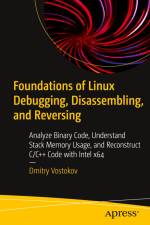av Dmitry Vostokov
567
This book will help you analyze traces and logs from different software environments and communicate analysis results using a pattern language that covers everything from a small debugging log to a distributed trace with billions of messages from hundreds of computers, thousands of software components, threads, and processes.The book begins with the basic terminology of operating systems and programming, the foundation for understanding trace and log analysis. It then talks about patterns that help describe problems from a user¿s view and patterns for errors and failures. Then, the book covers a range of trace patterns that group messages, and explores how logs depict software activities. It even examines specific message patterns and how they connect in a single trace. Moving forward, yoüll review patterns for multiple traces and logs and how to evaluate them. In this way, you can use similar methods to find problems across a wide variety of software. The book also provides guidance for analyzing issues on systems such as Windows, macOS, Linux, Android, iOS, and other types of computers, including those in networks and the Internet of Things, regardless of their system differences.Upon completing this book, you will be able to navigate the complexities of trace and log analysis and apply uniform diagnostics and anomaly detection pattern language across diverse software environments to help you troubleshoot, debug, and fix issues.What You Will LearnUnderstand pattern language for trace and log analysisGain a pattern-oriented methodology for trace and log analysis applicable to various domains, including cybersecurityMaster the fundamentals of operating systems and programming related to trace and log analysisUnderstand observed behavior in traces and logs, which aids incident response, diagnostics, root cause analysis, troubleshooting, and debuggingWho This Book Is ForSoftware technical support engineers, system and network administrators, software developers, testers, DevOps and DevSecOps, digital forensics and malware analysts, security incident response engineers, data analysts, and data mining practitioners.




